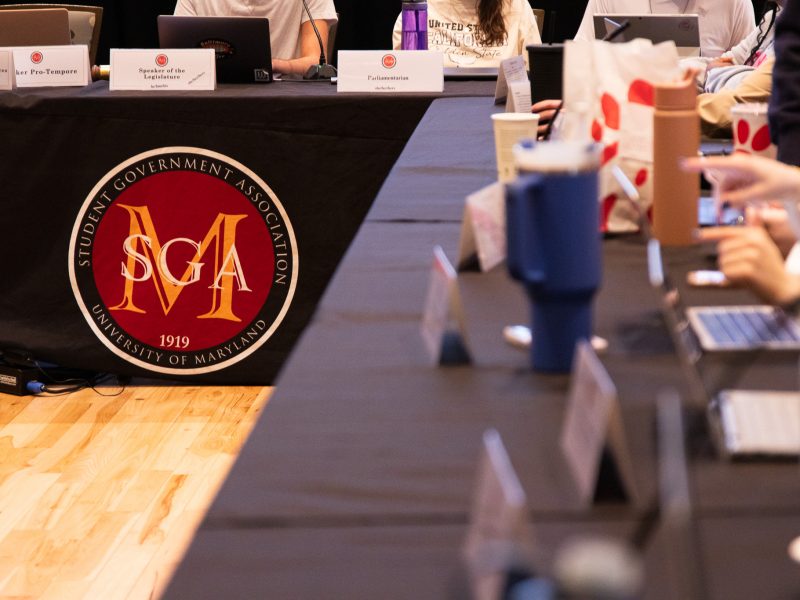University of Maryland faculty members are working to create an undergraduate major in immersive media design that would combine art and computer science department resources to educate students on concepts such as virtual reality.
The major would operate between the arts and humanities college and the computer, mathematical and natural sciences college, and would aim to enhance students’ knowledge of design for virtual and augmented reality platforms for purposes ranging from mapping to journalism to engineering.
“I’m glad we’re doing it, I predict we’ll have huge enrollments in that major simply because of the demand, enormous demand, from industry, from business, from the entertainment industry, for majors in that field,” university President Wallace Loh said.
A group of 17 faculty members are planning the major, and hope it will be available for students in fall 2019. It must first gain approval from the University Senate, Loh, the Board of Regents and the Maryland General Assembly, Associate Provost Betsy Beise said.
Beise called the fall 2019 goal “realistic but a little bit aggressive.”
[Read more: A UMD startup uses virtual reality to tell the story of Syrian refugees crossing Europe]
“It’s a lengthy process,” she said. “But I actually think that they’re far enough along in their thinking that we can probably get it moving.”
The program will likely involve two tracks — one focused on studio art and the other on computer science — said Audra Buck-Coleman, a design professor and an organizer for the major. Students in both tracks would work collaboratively on virtual reality- and augmented reality-themed projects, leading up to a capstone in their senior year, she said.
“The whole idea behind the major is really to mimic or create classrooms that are like the workplaces that a lot of these creatives and programmers … are going to be working in,” Buck-Coleman said.
The curriculum is still in the works, but the major may use resources from departments such as journalism, geography, art history and engineering, Buck-Coleman said. The courses will be “team taught,” she said, and could incorporate faculty from those subject areas.
“This is really the future,” Buck-Coleman said. “Right now, you kind of get in your discipline and you have this wonderful, enriching experience, but then you don’t talk to other disciplines, and you don’t interact in ways that could enrich your own studies.”
[Read more: Capital One will donate $3.1 million to UMD for comp sci research and lab space]
The project began as a suggestion from the Office of the Provost, which wants to draw students out of the crowded computer science major, Beise said. Computer science is the most popular major among undergraduates at this university, with nearly 3,000 students, according to the Office of Institutional Research, Planning and Assessment.
“What the provost is trying to do is identify opportunities for new majors that would be very appealing to students … and might relieve a little bit of the really heavy load,” she said.
Last semester, computer science students wrote to the university administration complaining about shortages of open seats in upper-level courses required for graduation. In response, college administrators added about 750 seats to courses.
In December 2016, officials surveyed students from related majors and honors programs about the prospective major. Of the 1,134 responses, about half said they “agree” or “strongly agree” that they would want to pursue “an immersive media design major that incorporates virtual and augmented reality technology.”
Amitabh Varshney, dean of the computer, mathematical and natural sciences college, said the major has been in development for about three years.
“Those who are more creative and artistically inclined will learn a high-level computer programming scripting language, and the folks who are more inclined toward programming … will get a high-level overview of art, art history, art theory and the principles of digital design,” Varshney said.
Bonnie Thornton Dill, dean of the arts and humanities college, said her college is eagerly anticipating the “forward-looking” major.
“Studying design in conjunction with […] virtual and augmented reality [students] will be able to tell stories that captivate audiences in new ways and immerse them in newly envisioned experiences,” she said in an email via Monique Everette, a spokeswoman for the college.
A $31 million donation from Oculus VR founder Brendan Iribe in 2014 and the opening of the Brendan Iribe Center for Computer Science and Innovation will provide resources for the major, Varshney said. The provost’s office is working to raise more funds for the major, Beise said, adding that they are seeking industry partners and donors.
The provost’s office is still working with faculty on the major’s name, Beise said.
“Immersive media design is not something that the typical high school student is going to understand right away what it is, but virtual reality is probably one they would,” she said.
This would be the second program based in more than one college at this university, Beise said. The other is environmental science and policy, which operates between the agriculture and natural resources college, behavioral and social sciences college, and the computer, mathematical and natural sciences college.
Jared Klemm, a freshman studio art major, said he liked the idea behind the major.
“It’s a cool concept,” he said. “Virtual reality is becoming a thing, and I think it’d be good to make the connection between comp sci and the art major.”



